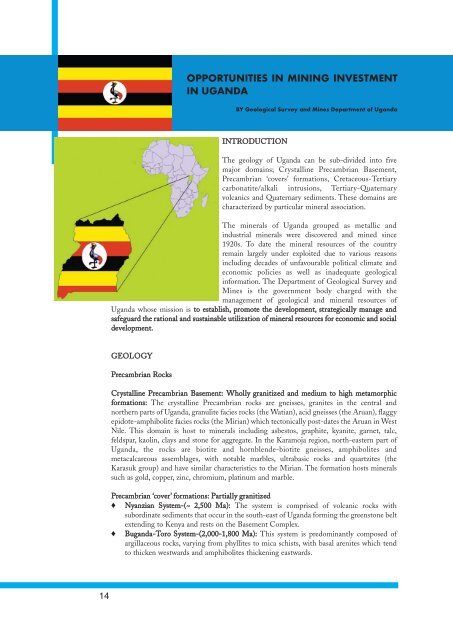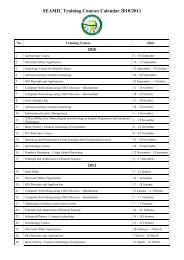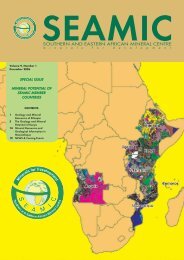SEAMIC Newsletter Vol. 10
SEAMIC Newsletter Vol. 10
SEAMIC Newsletter Vol. 10
Create successful ePaper yourself
Turn your PDF publications into a flip-book with our unique Google optimized e-Paper software.
OPPORTUNITIES IN MINING INVESTMENT<br />
IN UGANDA<br />
BY Geological Survey and Mines Department of Uganda<br />
INTRODUCTION<br />
The geology of Uganda can be sub-divided into five<br />
major domains; Crystalline Precambrian Basement,<br />
Precambrian ‘covers’ formations, Cretaceous-Tertiary<br />
carbonatite/alkali intrusions, Tertiary-Quaternary<br />
volcanics and Quaternary sediments. These domains are<br />
characterized by particular mineral association.<br />
The minerals of Uganda grouped as metallic and<br />
industrial minerals were discovered and mined since<br />
1920s. To date the mineral resources of the country<br />
remain largely under exploited due to various reasons<br />
including decades of unfavourable political climate and<br />
economic policies as well as inadequate geological<br />
information. The Department of Geological Survey and<br />
Mines is the government body charged with the<br />
management of geological and mineral resources of<br />
Uganda whose mission is to establish, promote the development, strategically manage and<br />
safeguard the rational and sustainable utilization of mineral resources for economic and social<br />
development.<br />
GEOLOGY<br />
Precambrian Rocks<br />
Crystalline Precambrian Basement: Wholly granitized and medium to high metamorphic<br />
formations: The crystalline Precambrian rocks are gneisses, granites in the central and<br />
northern parts of Uganda, granulite facies rocks (the Watian), acid gneisses (the Aruan), flaggy<br />
epidote-amphibolite facies rocks (the Mirian) which tectonically post-dates the Aruan in West<br />
Nile. This domain is host to minerals including asbestos, graphite, kyanite, garnet, talc,<br />
feldspar, kaolin, clays and stone for aggregate. In the Karamoja region, north-eastern part of<br />
Uganda, the rocks are biotite and hornblende-biotite gneisses, amphibolites and<br />
metacalcareous assemblages, with notable marbles, ultrabasic rocks and quartzites (the<br />
Karasuk group) and have similar characteristics to the Mirian. The formation hosts minerals<br />
such as gold, copper, zinc, chromium, platinum and marble.<br />
Precambrian ‘cover’ formations: Partially granitized<br />
♦ Nyanzian System-(~ 2,500 Ma): The system is comprised of volcanic rocks with<br />
subordinate sediments that occur in the south-east of Uganda forming the greenstone belt<br />
extending to Kenya and rests on the Basement Complex.<br />
♦ Buganda-Toro System-(2,000-1,800 Ma): This system is predominantly composed of<br />
argillaceous rocks, varying from phyllites to mica schists, with basal arenites which tend<br />
to thicken westwards and amphibolites thickening eastwards.<br />
14




